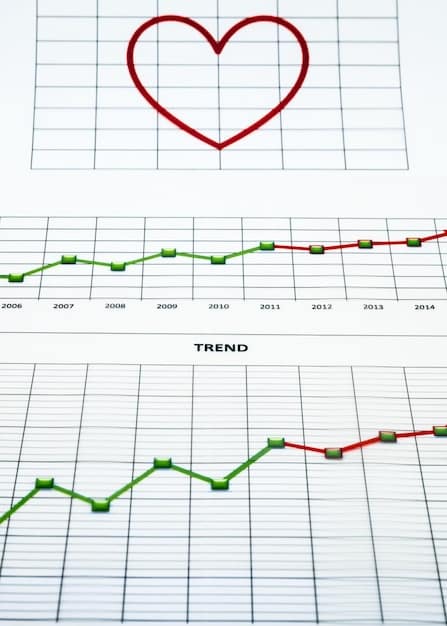Navigating Retirement: The Impact of Healthcare Costs in 2025

The Impact of Rising Healthcare Costs on Your Retirement Savings: A 2025 Analysis reveals that escalating medical expenses significantly erode retirement funds, necessitating proactive planning and strategic financial adjustments for future retirees in the United States.
Planning for retirement involves many factors, but one that’s often underestimated is the impact of rising healthcare costs. This article, “The Impact of Rising Healthcare Costs on Your Retirement Savings: A 2025 Analysis” delves into how these escalating expenses could affect your financial future and what you can do to prepare.
Understanding the Healthcare Cost Landscape in 2025
To understand the weight of healthcare expenses on retirement savings, it’s important to first grasp the overall changing dynamics of healthcare costs. This landscape includes factors like inflation, technological advancements, and demographic shifts.
Key Drivers of Healthcare Inflation
Healthcare inflation often outpaces general economic inflation. Several factors contribute to this trend:
- Technological Advancements: New medical technologies and pharmaceuticals drive up costs.
- Aging Population: As the population ages, the demand for healthcare services increases, leading to higher prices.
- Administrative Overhead: The complexity of the US healthcare system results in significant administrative costs.

Demographic Shifts and Healthcare Demand
Demographic shifts heavily influence healthcare demands. As the baby boomer generation enters advanced age, the need for geriatric care, chronic-disease management, and long-term care solutions grows, thereby escalating costs.
The convergence of these elements suggests that retirees in 2025 and beyond must strategically account for potentially substantial healthcare expenditures.
How Rising Costs Erode Retirement Savings
One of the most concerning aspects of escalating healthcare prices is how they gradually eat into your retirement savings. The money you had planned to use for leisure activities, travel, or even basic living expenses may need to be reallocated to medical care.
The Unexpected Expense of Long-Term Care
Long-term care is a significant but often overlooked expense. Many retirees find themselves needing assistance with daily activities, either at home or in a nursing facility. The costs associated with these services can be astronomical.
The financial impact can be devastating, especially if you haven’t planned specifically for it.
Impact on Investment Returns
Unexpected healthcare costs can force retirees to withdraw funds from their investment portfolios prematurely. This can hinder the portfolio’s ability to generate returns and potentially deplete savings faster than anticipated.

Strategies for Mitigating Healthcare Costs
While the prospect of rising healthcare costs can be daunting, there are proactive measures you can take to mitigate their impact on your retirement savings. Strategic planning and informed decision-making can make a significant difference.
Health Savings Accounts (HSAs)
Health Savings Accounts (HSAs) offer a tax-advantaged way to save for healthcare expenses. Contributions are tax-deductible, earnings grow tax-free, and withdrawals for qualified medical expenditures are also tax-free. They are a powerful tool for retirement healthcare planning.
These accounts can also act as an additional retirement savings vehicle, provided funds are used for qualified health expenditures.
Investing in Long-Term Care Insurance
Long-term care insurance helps cover the expenses associated with long-term care services, such as those provided in nursing homes or at home. While premiums can be costly, the protection it offers against significant financial strain can be invaluable.
- Assess Your Risks: Evaluate your family history and personal health risks to determine the right level of coverage.
- Shop Around: Compare policies from multiple insurers to find the best rates and terms.
- Consider an Inflation Rider: As healthcare costs rise, make sure your policy includes an inflation rider to maintain adequate coverage.
Lifestyle Choices and Preventative Care
Adopting a healthy lifestyle can reduce your risk of developing chronic conditions that require costly medical treatment. A balanced diet, regular physical activity, and avoiding tobacco and excessive alcohol consumption are crucial steps.
Preventative care, such as annual check-ups and screenings, can help detect potential health issues early, when they are often easier and less expensive to treat.
The Role of Medicare and Supplemental Insurance
Medicare is a federal health insurance program for individuals aged 65 and older, as well as certain younger people with disabilities or chronic conditions. While it provides essential coverage, it doesn’t cover all healthcare expenses.
Understanding Medicare Coverage
Medicare has several parts, each covering different types of services:
- Part A: Hospital Insurance, covering inpatient care, skilled nursing facility care, and hospice care.
- Part B: Medical Insurance, covering doctor’s services, outpatient care, and preventative services.
- Part C: Medicare Advantage, allowing enrollment in private health insurance plans that contract with Medicare.
- Part D: Prescription Drug Insurance, helping to cover the costs of prescription medications.
The Importance of Supplemental Insurance
Due to gaps in Medicare coverage, many retirees opt for supplemental insurance, such as Medigap policies or Medicare Advantage plans. These policies can help cover deductibles, co-pays, and other out-of-pocket expenses.
Planning and Budgeting for Healthcare in Retirement
Effective planning and budgeting are critical when ensuring your retirement savings can withstand the strain of rising healthcare costs. Start by estimating your healthcare expenses and incorporating these projections into your overall retirement budget.
Estimating Future Healthcare Costs
Use healthcare cost calculators and consult with financial advisors to estimate your future expenditures. Consider factors like your current health status, family history, and anticipated healthcare needs.
Regularly updating your estimates will help you adjust your budget accordingly.
Adjusting Your Retirement Portfolio
Work with a financial advisor to ensure your retirement portfolio is structured to accommodate potential healthcare expenses. This may involve adjusting your asset allocation, increasing your savings rate, or delaying retirement.
Financial planning professionals can provide personalized guidance based on your specific circumstances.
Navigating the Future of Healthcare Costs
The healthcare landscape is continuously evolving, influenced by policy reforms, technological breakthroughs, and societal needs. Staying informed about these changes can help you better prepare for the future impact of healthcare costs on your retirement savings.
Staying Informed on Policy Reforms
Keep abreast of healthcare policy changes at the federal and state levels. Changes to Medicare, Medicaid, and the Affordable Care Act can significantly impact healthcare costs and coverage options.
Embracing Technological Advancements
Technological advancements, such as telemedicine and remote monitoring, have the potential to reduce healthcare costs while improving access to care.
Being open to these innovations can help you leverage more efficient and cost-effective healthcare solutions.
Understanding the changing dynamics of healthcare costs, implementing mitigation strategies, and staying informed about policy reforms are crucial for protecting your financial future. Proactive planning and informed decision-making will ensure your retirement savings remain robust against rising healthcare expenses.
| Key Point | Brief Description |
|---|---|
| 💰 Healthcare Inflation | Rising costs due to tech advancements, aging population, and admin overhead. |
| 🛡️ Long-Term Care | Unexpected expenses from assisted living erode retirement savings. |
| 🏥 Health Savings Accounts | Tax-advantaged savings for healthcare expenses in retirement. |
| 🩺 Medicare Gaps | Supplemental insurance is vital to cover what original Medicare doesn’t. |
FAQ
▼
Use online healthcare cost calculators, consult with financial advisors, and consider your current health, family history, and anticipated medical needs for a reliable estimate.
▼
An HSA is a tax-advantaged savings account for healthcare expenses. Contributions are tax-deductible, earnings grow tax-free, and withdrawals for qualified medical costs are tax-free.
▼
Long-term care insurance can be valuable if you’re concerned about the high costs of assisted living or in-home care, but it’s essential to weigh the premiums against the potential benefits.
▼
Medicare includes Part A (hospital insurance), Part B (medical insurance), Part C (Medicare Advantage), and Part D (prescription drug insurance), each covering different aspects of healthcare.
▼
Work with a financial advisor to adjust your asset allocation, increase your savings rate, or consider delaying retirement to accommodate potential healthcare expenses.
Conclusion
As healthcare costs continue to rise, understanding their impact on your retirement savings becomes paramount. By implementing proactive strategies such as utilizing Health Savings Accounts, investing in long-term care insurance, making informed decisions about Medicare coverage, and prioritizing preventative care, you can ensure your retirement remains financially secure.





